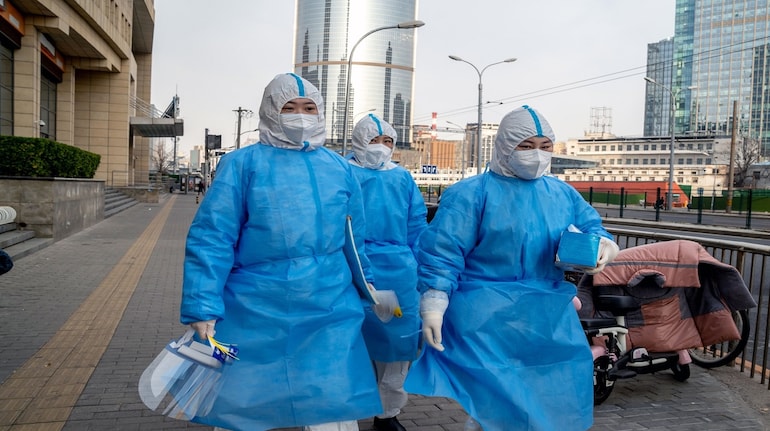
Representative image
It all started in China in late 2019. Three years down the line, the country, which until December 7 had a Zero Covid-19 policy characterised by massive quarantines, aggressive testing and strict travel restrictions, is confronting its worst coronavirus crisis.
Plagued by a wave of coronavirus cases, China is suddenly seeing its hospitals overwhelmed and crematoriums overloaded as unrestricted mingling of people over the last few weeks has resulted in a massive explosion of the viral infection.
The worry for the rest of the world, however, is that, as before, what happens in China may not stay in China.
For instance, the concern in India is that the rise of mutant variants in the neighbouring nation may cause a fresh surge of infections here. India has seen three waves of the pandemic so far, with the second one, triggered by the Delta variant of SARS CoV 2, turning out to be the worst.
For several months now, India has seen the pandemic ease to a comfortable level — as of now active infections in the country stand at just a little over 3,400.
With the country’s population having a high level of exposure to multiple SARS CoV 2 variants and more than 90 percent of adults covered by two full doses of the Covid-19 vaccine, experts say that there may be little for India to worry about. But anxieties remain.
It is for this reason that the government, too, has stepped up its effort to reinforce the measures adopted for pandemic control and has decided to accelerate the Covid-19 booster dose coverage for all adults.
Here is an explainer on what is happening and what measures may be necessary to mitigate the potential damage.
Why has the pandemic eased over the last few months?
Various variants of the Covid-19 virus have spread through most countries over the last three years. Today, most countries also have extensive vaccine coverage against the disease. Since November 2021, the Omicron variant of SARS CoV 2, said to be the most transmissible but also far less virulent variant (than the Delta variant), has been the dominant version globally.
Dr Vivekanand Jha, executive director of health research organisation George Institute for Global Health in India, explains that all viruses evolve over time to increase their chances of survival in a given environment.
Also read I COVID-19: Fresh push to booster shots for adults; focus this time on mix-and- match doses
This means two things: the ability to go from person to person and to evade an immune response that might have developed in hosts as a result of natural infection or vaccination. The behaviour of SARS-CoV-2, the virus that causes Covid-19, has exactly aligned with these expectations. And as we are seeing, the new variant emerging out of China is more infectious and better able to evade immunity.
Now, this might mean different things for people in China and in the rest of the world, he says, the risk is much greater for people in China, who are largely non-immune, whereas people elsewhere have developed varying levels of immunity.
“The reports from other parts of the world have so far indicated a stable level of transmission, but this could change,” said Jha.
Why is China witnessing a major surge in infections?
According to senior virologist Dr Gagandeep Kang, the situation in China is the result of a combination of four factors.
First, fewer than the required percentage of elderly people, the most vulnerable group, have received vaccinations.
Secondly, the penetration of booster vaccines in China is low.
Also, China had been focusing on massive quarantines and imposed stringent travel restrictions for almost three years, which were recently lifted amid growing unrest and public pressure. That relaxation has seen the virus spread as people mix freely.
On top of that, she said, this is flu season, when viral infections are rampant there.
Another virologist, Dr Shahid Jameel, who is associated with Oxford University, pointed out that China so far has relied on its own vaccines, which he said are not very good. “There is no indication of a new strain — they’re Omicron variants, so the culprit is low immunity,” he stressed.
What is the BF.7 strain and what do we know about it?
The BF.7 variant is the same as BA.5.2.1.7 strain, which is a sub-lineage of the Omicron sub-lineage BA.5 and was first detected in Northwest China’s Inner Mongolia Autonomous Region in early October this year.
This Omicron subvariant accounted for more than 5 percent of all Covid-19 cases and more than 7 percent of cases in the UK in October.
Experts associated with India’s SARS CoV 2 genomic surveillance programme said that BF.7, which has also been detected in India in small numbers, has more immune escape capability, a shorter incubation period, and a faster transmission rate, as compared to the BA.1, BA.2, and BA.5 variants detected previously.
“Evidence so far suggests that the new Omicron sub-variant is more infectious than previous variants and a person infected with the BF.7 variant can infect 10 to 18 people,” said an INSACOG scientist. “Even vaccinated people can be infected with the new Omicron sub-variant BF.7. However, there is no reason to suggest that BF.7 is capable of causing infection more severe than what other Omicron subvariants cause.”
According to Jha, given that viruses are constantly evolving — this is what viruses do — everyone is worried about whether the new variant is more pathogenic and causes greater organ injury.
But the worry would only be when there is a combination of high infectivity, a high level of immune evasion and increased pathogenicity, he stressed.
Should you worry about China’s Omicron BF.7 variant?
Despite having immune evasive characteristics and increased infectivity, the BF.7 subvariant, so far, has not shown any signs of triggering a major wave in countries with a history of hybrid immunity, or where populations groups have been exposed to previous SARS CoV 2 infections and been vaccinated.
“Don’t panic, but stay alert,” said India’s health minister Mansukh Mandaviya, after a high-level meeting on the pandemic status and preparedness in the country on December 21.
Dr Trupti Gilada, an infectious disease specialist with Masina Hospital in Mumbai, underlined that BF.7 variants’ symptoms are quite similar to those of other omicron subvariants, and include fever, sore throat and a runny nose.
“BF.7 variant cases of pneumonia are definitely fewer. Not too many hospitalisations have been seen with omicron and early data from countries also tell us that the mortality of BF 7 is low,” she stressed.
“The yardstick to measure the severity of this COVID-19 wave should not merely be the number of cases, since most of these would be mild,” Gilada said. “Instead it should be the number of moderate to severe cases — those requiring oxygen and immediate hospitalisation.”
What is the Indian government doing?
Some of the measures adopted by the government in the wake of Covid-19 situation in China include expanding vaccine booster coverage for adults, which stands at 28 percent currently, and stepping up genomic surveillance to identify new SARS CoV 2 in circulation quickly.
It has also been decided that a fresh advisory will be issued in a day or two for states to enforce Covid-19-appropriate behaviour ahead of Christmas and New Year celebrations.
Mandaviya also directed scientists to check if existing vaccines continue to protect against the virus variants in circulation and asked the Department of Pharmaceuticals to ensure availability of essential drugs, especially those used in the previous three Covid-19 waves.
Meanwhile the best way people can stay away from infection is by avoiding crowded places and by using good-quality masks, experts say.

